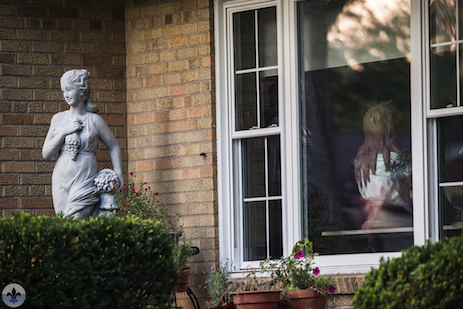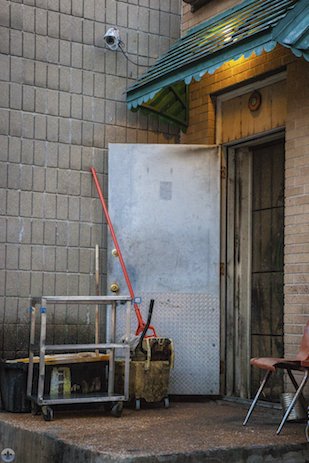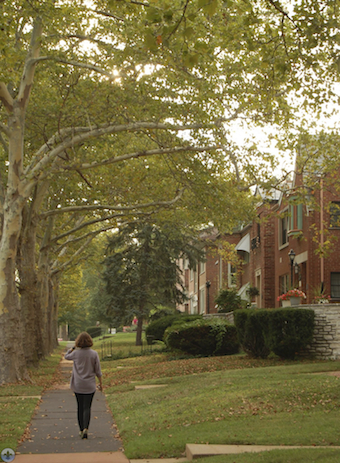photograph by Amanda Krebel
The St. Louis Hills neighborhood, one of the city’s youngest, is a beautiful residential neighborhood filled with homes and businesses reflecting both the Art Deco age of their origin and the neon-colored vibe of Old Route 66 (which passed through). Of all 79 neighborhoods in the city, this one is among the most intact and consistently occupied. So how does an entire neighborhood remain so desirable for over 80 years? On one side, the answer lays partially in the work that a devoted neighborhood association does to keep streets clean, parks serene and businesses open. On the other side, St. Louis Hills is an answer to the question, “What happened to places like The Ville and JeffVanderLou?” That said, there is very little not to like about this place, while strolling Francis Park on a warm summer afternoon with a Ted Drewes in hand.
photograph by Jeni Kulka
photograph by Jason Gray
photograph by Amanda Miller
photograph by Anne Warfield
photograph by Michelle Williams
The land that would become St. Louis Hills passed through several notable hands before becoming the neighborhood that we recognize today. As far as land owners, Pierre Laclede (St. Louis City Founder) and David Francis (former Governor of Missouri and President of the Louisiana Purchase Exposition) are but two early examples. In the 1920’s real estate developer, Cyrus Willmore, swooped in with his vision of “Country Living in the City.” It was around Willmore’s time that St. Louis Hills was officially recognized as a neighborhood. It was also around this time that restrictive deed covenants came into common practice for the city.
photograph by Mandi Gray
photograph by Theresa Harter
photograph by Anne Warfield
photograph by Susan Price
photograph by Kristi Foster Photography
A restrictive deed covenant was a neighborhood-initiated contract that the homeowner signed which essentially enforced segregation, without violating the law at the time. Restrictive deeds grew out of a complicated racial landscape for the city of St. Louis (and Missouri). In 1915, St. Louis became the first city to enforce a segregation ordinance by initiative. The original proposal was petitioned by an organization called the “United Welfare Association (U.W.A.)”, and once on the ballot, it passed by a margin of 52,000 to 18,000. The segregation law essentially stated that if at least 3/4 of a neighborhood’s population were of a single race, another race cannot establish a new residence in the neighborhood. The U.W.A. argued that this measure would ease tensions between races. In 1917, the United States Supreme Court overturned all existing segregation ordinances in a ruling against the city of Louisville, Kentucky. Shortly thereafter, the secretive practice of restrictive deed covenants was employed to circumnavigate the court decision, and was championed by many real estate developers in St. Louis, including the St. Louis Hills Realty Company (owned by Willmore). That said, for some realtors, using restrictive deeds was more of a decision to remain competitive in business (awful by human rights standards) than to support oppression; it is not clear as to which side Willmore was on. Nonetheless, as St. louis Hills grew to become a thriving, tree-lined community that welcomed all new white residents with a bouquet of roses and a ranch-style house, neighborhoods near the urban core, like The Ville and JeffVanderLou, were over-flowing with black residents, a symptom of there being not enough “negro districts”, the Great Migration, and the destruction of the Mill Creek Valley tenements (the early success of both neighborhoods is almost unfathomable given the population density). The practice of restrictive deed covenants was finally abandoned after the Civil Rights Movement of the 1960’s, but racial distinctions between neighborhoods do still remain, as evidenced in St. Louis Hills’ 2010 census statistic of having more than 94% white residents in a city that registered as pre-dominantly black (>49%). Of course, this is not exactly a fault of current residents, but of historical circumstances, and all races are welcome throughout the neighborhood today.
photograph by Jeni Kulka
photograph by Robbie Hart
photograph by Jocelyn Clemens
photograph by Ann Aurbach
Currently, St. Louis Hills is a vibrant community and one of the best-preserved in the city. This is in no small part due to the activity of the St. Louis Hills Neighborhood Association, which does an excellent job maintaining facilities and providing support to residents and business owners. One business, Ted Drewes Frozen Custard, has operated in St. Louis Hills since 1941, and is beloved throughout the STL region to this day. It is likely that Drewes selected its current spot on Chippewa Street due to the fact that Route 66 came down this corridor.
photograph by Dawn Mills
photograph by Michelle Williams
photograph by Dan Henrichs Photography, St. Louis
photograph by Jason Gray
photograph by Kristi Foster Photography
Our endpoint for Photo Flood 25 was Pueblo Solis, which did an excellent job accommodating our large group. If you have not tried this restaurant, we highly recommend it; the margaritas are potent and everything that we ate was delicious!
photograph by Jason Gray




























How do people know when the next flood is? I’ve signed up and follow you on FB.
Hi Diane,
Will you please send a link to your FB profile to photofloodstl@yahoo.com? I will get you set up this way.